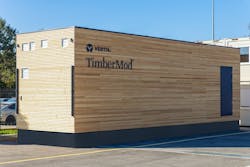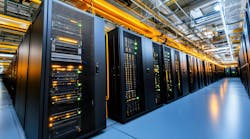Wind, Wood, Water, Wilderness: Elemental Data Center Innovations Boost Edge, Sustainability Plays
Recent trending industry news stories have seen unique data center innovations drawing sustenance from the natural world, and/or more seamlessly inhabiting its environs.
This article rounds up the developments, with an eye toward data center sustainability and edge advancements.
Wind
As recently reported by CNN, while efforts to reduce the carbon footprint of data centers using renewables such as wind energy are ongoing, a new technology project in Germany takes reliance on wind power one step further. Data centers inside wind turbines? This novel idea for sustainable data has been pioneered by windCORES, a German firm which has built several data centers inside the base of wind turbines.
Founded in 2018, WindCORES is a subsidiary of German renewable electricity company WestfalenWIND. Located on a site in a wind park in western Germany's Paderborn district, operating its data centers inside wind turbines renders the facilities almost carbon-neutral, asserts the company.
As Fiete Dubberke, managing director of windCORES, told CNN, “If you look at the sustainability pyramid, the highest form of sustainability is using things that already exist.” The company uses its existing wind turbines to power data centers on-site, for which fiber-optic cables furnish a constant internet connection.
Dubberke explained that planning for the data center project began a decade ago, when WestfalenWIND realized that the utility grid was too weak to handle the giant capacities of electricity being produced by its wind turbines during peak wind hours.
This situation resulted in its windfarms being taken offline, owing to grid security issues. Per the CNN reporting, windCORES estimated that the unused electricity generated during this period could power one-third of all German data centers.
The company's solution was to bypass the the grid altogether, and instead, power IT servers from directly inside the stately concrete wind turbine towers, each of which is 13 meters wide, and could feasibly contain server racks up to 150 meters high. As the area inside the wind turbines is mostly empty space, windCORES' Dubberke called the data center concept a “no-brainer.”
He added that, on average, 85-92% of the power needed to sustain a data center housed in a wind turbine comes directly from the host turbine. When there is no wind, electricity is obtained from other renewable sources via the electricity grid, including solar energy farms and hydroelectric power plants.
In terms of pure decarbonization, Dubberke told CNN, “The German data center average is 430 grams of CO2 released per kilowatt hour. For windCORES, it is calculated at just 10 grams per kilowatt hour.”
Since launching, windCORES has acquired around 150 clients through co-location and cloud platforms, from tiny start-up companies to larger, more established ones, including s Zattoo, a carbon-neutral Swiss TV streaming platform with several million monthly users.
Asim Hussain, chairperson and executive director of the non-profit Green Software Foundation, told CNN that the windCORES concept is “quite clever” because it battles one of the biggest issues in renewable energy: a concept known as curtailment.
“When there’s more electricity being generated than people are consuming, you can’t store it, there’s no big batteries – so you just have to throw it away; that’s curtailment,” explained Hussain.
He concluded, “Now, it doesn’t matter even if [windCORES is] told [by the utility grid] to throw electricity away - they’ve got their own data center to power.”
Wood
Extending the industry's quest for a climate-positive Wooden Data Center, in late November, Vertiv announced the launch of its prefabricated mass timber platform, positioned to help increase data center sustainability in North America and Europe, Middle East and Africa (EMEA) locations.
Vertiv says the TimberMod platform's innovation reflects the company's commitment to supporting its customers' sustainability objectives by using a more environmentally-friendly material that can minimize resource depletion and lower CO2 emissions.
Featuring mass timber as opposed to steel as a key structural component for standardized, customizable prefabricated modular (PFM) data center construction, the company claims that TimberMod, a variant of its Power Module and SmartMod families, can significantly reduce carbon footprint compared to steel alternatives.
“We are dedicated to finding innovative solutions that can help reduce data center carbon footprints through the use of environmentally friendly construction materials and processes,” said Viktor Petik, vice president and EMEA leader for Vertiv’s Integrated Modular Solutions business.
The company contends that mass timber, if sourced from sustainably harvested wood, serves as a renewable construction material with the potential to minimize resource depletion and lower carbon footprint by up to 3x, as compared to steel.
Such estimates are based on the reduction of CO2 emissions associated with the cradle-to-gate product lifecycle, and the transport of materials and structural elements to the assembly site.
Vertiv's Petik added, “By incorporating materials from renewable sources, Vertiv TimberMod not only provides a more eco-friendly option but does so without compromising on performance, thus creating a positive impact on both the environment and our customers' operational efficiency.”
Now available in North America and EMEA, Vertiv says its TimberMod offering meets applicable building structural requirements, providing robust performance in the face of seismic activity, wind forces, and structural demands.
Beyond its structural prowess, Vertiv contends the innovative solution "adds an aesthetic dimension to data center architecture, seamlessly blending into diverse environments with an elegant design."
As quoted in a press release, Vlad Galabov, director for cloud and data center at technology research and advisory group, Omdia, remarked, “Although timber data centers are not new, they have become much more accessible now that a major prefabricated modular data center vendor offers data center building blocks or an entire data center built with timber, with the engineering assurance that it will remain reliable."
And what about fire protection? Are the wood data center containers fireproof? Attesting to the fire-resistant capabilities of timber data centers, Vertiv architect Ela Ptiček recently explained to Data Center Knowledge: “Our solution provides for the encapsulation of the structure. This method aligns with established safety standards, such as Eurocode 5, and is recognized as an acceptable practice in building codes. This approach provides for minimal contribution of the structural components to the fire risk, meeting stringent fire rating requirements (e.g., EI60, EI90, EI120).”
Water
Notionally in the pipeline since at least 2016 when it was given a serious a trial with Microsoft's Project Natick, along with receiving surface traction by near-industry proponents such as Nautilus, the idea of underwater data centers is one that won't sink, which has resurfaced again in China, if we believe what that country's state media reported at the end of November.
The report in China Daily stated that more than seven companies and institutions, including China Telecom and Tencent, are now onboard to receive client storage and computing services from what's being billed as the world's first commercial undersea data center, located near South China's Hainan province, according to its builder, Beijing Highlander Digital Technology Co.
China Central Television claims that Highlander's undersea "supercomputer" is equivalent to 60,000 regular computers operating in unison, and can process more than 4 million high-definition images within 30 seconds. Datacenter Dynamics has recorded the history of the Highlander project.
The core equipment of the commercial underwater data center, with a design life of 25 years, has been successfully installed, said the report. Weighing 1,300 metric tons, about the weight of 1,000 automobiles, the data center equipment reportedly reached a depth of 35 meters after nearly three hours of submersion operations.
The data center connects modules to a shore station using undersea cables (a potentially dicey proposition in itself, according to fiber-optic industry commentary in Light Reading). Subsystems such as power distribution, networking and monitoring equipment are housed inside the shore station; staff can keep an eye on the modules via an underwater monitoring system.
As data centers such as the purported one by Highlander in China are located offshore on the seabed, seawater provides natural cooling for the facilities' modules. While consuming less energy, water and land area than an onshore facility, the Hainan center also has the benefits of higher computing power density, better security and reduced network lag, according to its builder.
The Conversation recently published an article highlighting the potential energy-saving, cost and latency advantages of undersea data centers.
The Highlander data center project in Hainan reportedly plans to deploy 100 modules, and when completed is forecast to save 122 million kilowatt-hours of electricity. The project is also billed as conserving 68,000 square meters of construction land and 105,000 metric tons of fresh water per year, compared to a traditional land-based data center of the same size.
As quoted in China Daily, Pu Ding, general manager of the Highlander facility's Hainan demonstration development project, said the underwater data center adopts gravity heat pipe technology and uses seawater as a natural cold source, a method which can achieve overall energy efficiency improvements ranging from 40 to 60 percent.
The China Daily report contends that the Highlander undersea data center has drawn international visitors from Singapore, Saudi Arabia, and the United Arab Emirates. The builder reportedly plans to promote the data center's service in China's Yangtze River Delta, Greater Bay Area, and overseas.
Wilderness
Finally, SpaceNews is this month reporting that year-old data networking startup Armada has raised more than $55 million for portable, modular data centers that could be rapidly deployed to remote geographical regions, while seamlessly integrating with Starlink's satellite network (Starlink is SpaceX’s low Earth orbit broadband distribution platform).
Designed to be about the size of shipping containers, at approximately 9 meters in length, Armada says its Galleon data centers would provide off-the-grid sites such as oil rigs and battlefields with real-time data processing capabilities, including those for generative AI platforms, usually limited to areas with terrestrial connectivity.
SpaceNews reported that "the technology would employ SpaceX’s satellites for global connectivity, leveraging an operating system that a customer could use to manage multiple Starlink deployments across their business."
An Armada spokesperson told SpaceNews that most of the company’s 60 employees are based in Bellevue, Washington, close to where SpaceX builds Starlink satellites.
Armada did not say whether it is partnering with SpaceX, who reportedly has not commented on the venture. Other key details, including how far away Armada is from commercial operations, also remain shrouded.
Founders Fund, an early SpaceX investor, reportedly led Armada’s funding round alongside venture capital firms Lux Capital, Shield Capital, and 8090 Industries.
About the Author
Matt Vincent
A B2B technology journalist and editor with more than two decades of experience, Matt Vincent is Editor in Chief of Data Center Frontier.


